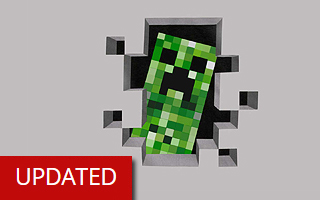Game Changers of the 1970s
Top 10 Most Important Video Games of the 1970s!
This list looks at the most important video games of the 1970s. These games captivated audiences, influenced developers, and inspired change within the industry. In some cases, they introduced new gameplay concepts that were adopted by the gaming world. In other instances, they helped the medium grow and evolve by attracting new audiences. This isn’t necessarily a list of the best games, and it’s not even a list of the most innovative games. The most creative games aren’t always the ones that catch on, and luck has a big role in any growing industry. The 1970s was a time of great change for the gaming world. Experimental video games had existed since the 1950s, but the ’70s saw the birth of the arcade scene, the rise of home consoles, and exponential growth within the home computer market. The decade transformed gaming from a niche hobby to a multimillion-dollar business. Video games didn’t start in the ’70s, but the video game industry did.
10
Death Race
1976

In 1975, Exidy developed a simple racing game called Destruction Derby and licensed it to Chicago Coin. When Exidy ran into financial troubles the following year, they decided to modify the game so they’d be able to introduce it to new distributors. The goal in Destruction Derby was to crash into other cars in order to score points, but Death Race tasked players with running over human-like “gremlins” instead. The gremlins would let out an audible screech after being hit, and they would leave behind a cross to mark their apparent grave. Death Race was initially planned as an interim game that would keep Exidy solvent until they could release a new title. Plans changed after an Associated Press reporter saw the game at a Seattle arcade. Expressing concern’s about the game’s violent content and its potential to affect those playing it, the reporter wrote an unfavorable review of the game in a widely disseminated article. Over the course of the next year or so, other national newspapers like The New York Times wrote similar hit pieces. Modern research proves that there is no link between video games and violent behavior, but journalists got as much mileage out of the controversy as they could. The negative press only served to increase the game’s popularity, and this began a long-standing tradition. If it wasn’t for the manufactured outrage, it’s unlikely we’d even be talking about Death Race today.
9
Galaxian
1979

Galaxian was Namco’s attempt to cash in on the success of Space Invaders. The game centered around swarms of alien armies, and player’s were required to blast away at them from a spaceship that was positioned at the bottom of the screen. The Space Invaders influence is impossible to ignore, but this isn’t to say that the game didn’t offer anything in the name of innovation. Galaxian featured animated explosions, a scrolling starfield, and it pioneered the use of multi-color sprites. The game was a lot more colorful than Space Invaders, and the gameplay was more sophisticated as well. The alien ships were much more agile in Galaxian, and their attack patterns were more complex. Instead of merely moving left and right across the screen, they would occasionally perform kamikaze-like dives at the player’s ship. This introduced an element of drama that was not seen in similar games. It didn’t necessarily change the gaming world in the way that Space Invaders did, but Galaxian could still stand on its own merits. If nothing else, it established Namco as a major player in the video game industry.
8
Combat
1977

Combat was one of nine launch games released alongside the Atari 2600 in 1977, and it was included as a pack-in title for several years. The title was a derivative of a 1974 arcade game called Tank, but it had a lot more content and featured 27 different game modes highlighting various combat scenarios. Most of these scenarios centered around the game’s tank-based modes, but Combat also featured bi-planes and jet fighters. There were several different map layouts in the game, players could choose the type of ammunition they wanted to use, and there was even a mode that made the tanks invisible! The game is perhaps best remembered for the “Tank Pong” mode which allowed the ammunition to bounce off of walls. It’s not the prettiest game on the system and it’s certainly not the most complex, but the two-player action made Combat one of the most replayable games to ever grace the Atari 2600. It was the shining jewel in the console’s launch lineup, and it stands as one of the system’s best games to this very day. Combat was arguably the best console exclusive of the 1970s, and it offered players with more options than arcade games of the era did.
7
Asteroids
1979

Asteroids is a vector-based shooter that was designed by Lyle Rains, Ed Logg, and Dominic Walsh of Atari. The objective of the game is to fly a small ship around in asteroid field. Shooting asteroids causes them to break into smaller ones, and the resulting asteroids will travel at varying speeds depending on their size. In addition to the asteroids, you’ll also have to contend with flying saucers that periodically show up. Since the game takes place in outer space, it’s very easy to build momentum. The key to success is understanding how to control this momentum, and the inertia allows you to shoot in one direction while your ship is moving in another. In desperate situations, players can also initiate a jump into “hyperspace” – which effectively warps their ship to a random location on the screen. Asteroids combined the physics model of Computer Space with the “eliminate all threats” dynamic of Space Invaders, and the constant juggling of speed and positioning gave the game an addictive quality. Asteroids was Atari’s best-selling arcade game of all time, and it was their most influential title since Pong. The game was so successful that arcade owners had to install larger coin boxes to hold all the quarters that players were plunking into the machines!
6
The Oregon Trail
1978

In 1971, a history teacher named Don Rawitsch was looking for a way to teach his students about life on the Oregon Trail in the 19th century. To that end, he teamed up with a couple of colleagues (Bill Heinemann and Paul Dillenberger) to develop a text-based strategy game for the HP 2100 minicomputer that his school district had recently purchased. The Oregon Trail kept track of your food, ammunition, clothing, cash, and mileage as you led a party of settlers from Independence, Missouri, to Oregon City. Along the way, players had to deal with random events like storms, wagon breakdowns, and wild animal attacks. Although the game was popular with students, it was deleted from the school mainframe at the end of the semester. The game left a lasting impression, however, and Rawitsch was hired by the Minnesota Educational Computing Consortium (MECC) to develop educational software in 1974. At this point, Rawitsch created an enhanced version of the original game with altered probabilities. The earliest version of The Oregon Trail relied on paper printouts instead of computer monitors. They could be describe as computer games, but it be a stretch to call them video games. The game was given a proper graphical interface when it was ported to the Apple II in 1978, however, and the 1985 upgrade was substantially improved. A lot of people view video games as a waste of time, but The Oregon Trail was a the most visible example of how they could be used as a learning tool. The game was a smashing success for MECC, and their educational software was sold to schools across the country. All told, the various iterations of The Oregon Trail have sold over 65 million copies. That’s a whole lot of learning!
5
Colossal Cave Adventure
1976

Colossal Cave Adventure (also known as ADVENT, Colossal Cave or, simply, Adventure) is a text adventure game that was first released in 1976. Will Crowther originally developed the game for a PDP-10 mainframe, but it was later expanded with the help of Don Woods and ported to various gaming platforms. The object of the game is to explore a mysterious cave that is presumably filled with treasure. Players control their character through simple text commands, and they are able to interact with objects, manage their inventory, and venture deeper into the “maze of twisty little passages.” The player’s commands are simplistic by design, but the game replies with a humorous, conversational tone that could be likened to a D&D dungeon master. It may seem simple by today’s standards, but Colossal Cave Adventure was one of the first examples of interactive fiction, and it stands as one of the most influential games of all time. The game directly inspired the creation of titles like Zork, Rogue, Mystery House, and Atari’s Adventure – all of which were influential games in their own right. Colossal Cave Adventure basically laid the groundwork for the entire adventure game genre.
4
Computer Space
1971

In 1962, a group of engineers programmed an experimental video game called Spacewar! for the newly-installed DEC PDP-1 at the Massachusetts Institute of Technology. The game centered around two spaceships engaged in a dogfight near a gravity well. It was a simple concept, but there were several variables to be mindful of. Players had a limited number of missiles, for example, and the Newtonian physics model meant that ships would remain in motion even when the player wasn’t accelerating. The game eventually spread to other campuses, but it never had much exposure outside of the small programming community. Nine years after Spacewar! was revealed, Nolan Bushnell and Ted Dabney set out to make a coin-operated version of the game. Working closely with Nutting Associates, the duo tested several prototypes before settling on a final design. The game was re-branded as Computer Space for marketing purposes, and it was enclosed in a futuristic fiberglass cabinet that Bushnell designed himself. Although Computer Space was a derivative of Spacewar!, it holds a place in history as the first commercially released video game. The game was only a moderate success, however, and it proved to be too complicated for mainstream audiences. Computer Space had a steep learning curve, and the complexity of the controls were a major turn-off for potential customers. Busnell and Dabney were trying to build a new industry, and they learned a valuable lesson from Computer Space. After incorporating Atari in 1972, the duo decided to focus on simple and intuitive games that anyone could play.
3
Table Tennis
1972

Released in September of 1972, the Magnavox Odyssey is recognized as the world’s first home video game console. The revolutionary box was developed by a small team at Sanders Associates led by Ralph Baer. The rudimentary console could only display three square dots on the screen, it was strictly black-and-white, and there were no sound capabilities to speak of. (It was bundled with plastic overlays that could be placed on the television screen to create visuals, however.) It was also packaged with dice, paper money, and other board game accessories that could be used in conjunction with various games. Twelve game cards were included with the console when it launched in America, and Table Tennis was the only one that didn’t require an overlay or additional elements. Some of the titles blurred the lines between video games and board games, but Table Tennis gave players a clear objective. The purpose of the game was for players to knock a ball back and forth across the screen. The game didn’t have a title screen, it didn’t keep track of the score, and it was simply referred to as “1” on the game card itself. It wasn’t especially creative, either, and the concept of a tennis game is something that had already been explored. (William Higinbotham’s Tennis for Two was demonstrated on an oscilloscope screen at a technology exhibition way back in 1958!) That being said, the Odyssey brought video games to the masses, and its importance to the industry cannot be overstated. Table Tennis also served as the inspiration for Atari’s Pong, which leads nicely to our next entry.
2
Pong
1972

Atari’s Pong was released after Magnavox’s take on electronic table tennis hit store shelves, but it had a much bigger impact on the industry. It was also a vastly superior product and had features that its Odyssey counterpart lacked – including sound effects, on-screen scoring, and the ability to put spin on the ball. An engineer named Allan Alcorn designed the game as a training exercise assigned to him by Atari co-founder Nolan Bushnell, and the result was the first commercially successful arcade game. A Pong prototype was placed in a local Sunnyvale bar in the summer of 1972, and its popularity grew for a couple of weeks until the machine began exhibiting technical issues. As it turned out, the problem was that the coin mechanism was overflowing with quarters! Bushnell was planning on licensing the game to ether Bally or Midway, but the success of the prototype inspired Atari to manufacture the game themselves. The fledgling company began shipping cabinets by the end of the year, and the industry was changed forever. A stand-alone home version of Pong hit the market in 1975, and several sequels were released that added new features. Other companies began producing similar games too, and the video game market was completely dominated by Pong clones for the better part of a decade.
1
Space Invaders
1978

Space Invaders is a simple game in which players move a cannon along the bottom of the screen and shoot down waves of alien ships. Although Space Invaders wasn’t the first game that let you shoot down enemy spacecraft, it was one of the first where your enemies would shoot back! You could even take cover from enemy fire behind destructible barriers. Space Invaders was also the first game to use a continuous background soundtrack. The music consisted of four descending bass notes repeating in a loop, but the pace increased as enemies approached and it almost felt like a heartbeat. Without question, the biggest contribution Space Invaders made to the industry was its ability to record high scores. Leaving your initials on the high score table effectively allowed you to compete with other players you had never even met, and this introduced an important social element to the gaming world. With the success of Space Invaders, video games evolved from a mere novelty to a global industry. Video game cabinets began showing up in mainstream locations like restaurants and department stores, and specialty arcades opened with nothing but Space Invaders cabinets. Taito moved 100,000 units by the end of 1978 in Japan alone, and the profits were more that double what Star Wars raked in during its record-breaking box office run. The home versions of the game were wildly successful, too. When the game was ported to the Atari 2600 in 1980, it moved over two million in its first year and effectively quadrupled the system’s sales. As the first console game to sell over a million cartridges, it can be regarded as the industry’s first killer app. Adjusted for inflation, all versions of Space Invaders have grossed over $13 billion in revenue, making it the most successful video game of all time. The game also inspired countless game designers, and its release marked the birth of an art form.





Do you agree with this list? Let us know what you think by leaving a comment below. Your opinion matters!